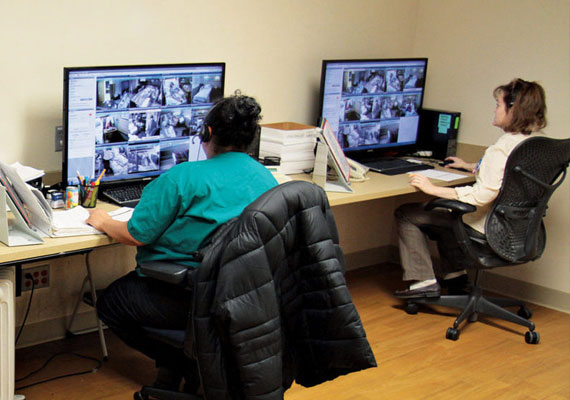Struggling with maintaining your Virtual Safety Team? You’re not alone.
No topics assigned.
April 18, 2023
Here are best practices for recruiting and retaining virtual safety attendants for your TeleSitter® program.
Struggling with maintaining your Virtual Safety Team? You’re not alone.
Here are best practices for recruiting and retaining virtual safety attendants for your TeleSitter® program.

It’s no secret that healthcare is impacted by staffing shortages and turnover. During the past year, hospital turnover increased by 6.4% and currently stands at 25.9%. Recruiting and retaining virtual safety attendants is more challenging than ever. The “secret sauce” to maintaining a successful video monitoring program is in the details. We recently sat down with the experts to discuss how they created the sought-after role of a virtual safety attendant. Watch the webinar and see below for best practices for hiring, onboarding, and maintaining a program that keeps your virtual safety attendants engaged. Thought leaders:
- Lori Colineri, DNP, RN, NEA-BC, Chief Nursing Officer, Hackensack Meridian Health
- Tiffany Villamin, MSN, RN, CRRN, Nurse Manager, Patient Flow Support Services, VA North Texas Health Care System
- Lisbeth Votruba, MSN, RN, Chief Clinical Officer, AvaSure
“When you hire right, you will have staff committed to the mission and to keep the program sustainable”
– Tiffany Villamin, MSN, RN, CRRN, Nurse Manager, Patient Flow Support Services, VA North Texas Health Care System
Finding the Right Talent is Critical to Success
It all starts with hiring. Virtual safety attendants are the lynchpin of a successful video monitoring program. A dedicated monitor staff member is one who makes patient care their top priority.
Proven tips:
- Use AvaSure’s job roles & responsibilities and job description templates to kickstart your search
- Look for candidates with at least one year of healthcare experience in rehab, acute care, and psychology settings
- Beyond their resume, look for candidates who embody accountability, empathy, courage, and reliability.
- If there is a labor shortage, partner with a staffing organization, like Equum Medical, to augment your team.
- Work with local schools to create a pipeline program for nursing or allied health students.
BEST PRACTICE: Hackensack Meridian Health developed an “earn while you learn” program that helps learners get familiar with monitoring systems, work in the hospital setting, and communicate with patients. This program creates a pipeline of talent ready to take on new roles in the organization as they graduate. As an added bonus, those who went through the program are advocates for your virtual monitoring program throughout their careers.
Onboarding and Education Sets the Right Tone
Your onboarding strategy is the first impression of your monitoring program and sets the tone for the attendant’s experience. A robust training program helps to build staff confidence, and better engagement with their patients.
Proven tips:
- Use AvaSure’s education modules in your regular Learning Management System (LMS) for virtual safety attendants, nursing staff, nursing leaders, and non-nursing leaders.
- Hold an in-person or virtual open house to introduce your bedside nurses and virtual safety attendants.
- Have monitor staff spend the first 2-3 months monitoring full-time to get comfortable with the skillset required for TeleSitter® and then train them at the bedside, expanding their skillset.
- Use AvaSure’s competencies and skills checklists to prepare virtual safety attendants to confidently fly solo.
BEST PRACTICE: Hackensack Meridian Health recognized that everyone plays a role in their monitoring program. They use AvaSure’s learning modules in their LMS for nursing and non-nursing roles so that when a STAT alarm goes off, everyone knows what to do without question. Those investments are worthwhile. Hackensack Meridian Health outperforms industry benchmarks on verbal interventions and STAT alarm response time.
Recognition and Career Planning Keeps Staff Engaged
The best way to keep your video monitoring program strong is to retain your core talent. The program hinges on the reputation of your virtual safety attendants as trusted partners to the nursing staff.
Proven tips:
- Ensure managers consistently check in on their team’s well-being, guaranteeing they are getting the breaks and support needed to remain focused on patient safety.
- Create a career path for roles like medical assistant, clerk, registered nurse, and phlebotomist to encourage positive turnover.
- Build a “great catch” program to recognize virtual safety attendants’ impact on patient safety as critical members of the team.
BEST PRACTICE: VA North Texas Healthcare System designated a nurse responsible for administrative duties that ease the burden on the virtual safety attendant staff. This person is responsible for clinical coordination, data review, staff relief, education, and collaboration with the nursing staff. This role improved the partnership with nursing and raised the number of patients enrolled in the program.
A successful virtual monitoring program improves patient safety while giving back to bedside nurses, and the strength of your program relies on the dedicated people behind the screen. More than technology, AvaSure is committed to the success of your TeleSitter® or TeleNurse™ programs. Pulling from our experience building virtual care strategies in over 1,000 hospitals and health systems, AvaSure’s clinical team partners with hospitals to ensure that their virtual safety attendants are confident, engaged, and seen as valued members of the team.
Ready to get started?
Get in touch with an AvaSure representative to learn more about AvaSure's AI-enabled virtual care solutions.
